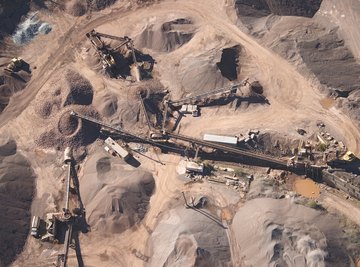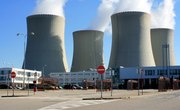
Uranium mining is the beginning of the nuclear chain. Industries such as nuclear power and the manufacturing of nuclear weapons would be impossible without a steady supply of uranium ore. The only economically and environmentally practical way to obtain that uranium is by mining it out of the ground.
Environmental Impact
One advantage uranium mining has over production methods used to retrieve fossil fuels is that plants need much less uranium to create electricity than is required if using coal, natural gas or oil. One kilogram of uranium provides the same amount of energy as about 100,000 kilos of oil or nearly 220,000 kilos of coal. Less material means less mining and a smaller impact on the environment.
Wide-spread Usage
The uranium obtained from mining is used in a number of nonmilitary and nonenergy industries. Radioisotopes derived from uranium are used in a number of medical settings, from treating cancer to sterilizing medical equipment. Radioisotopes are used in measuring, testing and analyzing industrial materials and in commercial products like smoke detectors. They are also used as a way to preserve harvested crops and protect fragile crops during transport.
Supply
Depending on which estimate you believe, Earth's supply of easily obtainable oil will be exhausted in somewhere between 75 and 125 years. The supply of coal that is economically practical to mine is estimated to be exhausted in about 150 years. However, an article in the American Journal of Physics estimated that if the current rate of uranium mining continues at a steady pace, enough uranium exists in all the world's oceans and the Earth's crust under the oceans to last 5 billion years.
Jobs
A recent study commissioned by the New Mexico Environmental Law Center estimates that a proposed expansion of uranium mining would bring $30 billion and more than a quarter of a million jobs to the state over the next decade. In the 20th century, the United States was the world leader in uranium mining, but in the past decade, Kazakhstan, Canada, and Australia have eclipsed it.
Economic Impact
The Canadian province of Saskatchewan includes some of the largest and most productive uranium mines in the world. According to a recent study by the Saskatchewan Mining Association, the uranium mining industry will be investing over $40 billion CAD in facilities and equipment locally in the next 5 years. Overall, mining contributed 12 percent of the province's overall gross domestic product in 2008. That amounts to $7.7 billion CAD. You can find a similar economic benefit in other areas around the world that boast a concentration of uranium mining.
References
About the Author
Stephanie Ellis has been a journalist since 1987. She began her career working at a small-town newspaper, but in the years since she has been published in outlets from "The Chicago Tribune" to CNN.com. She holds a Bachelor of Arts in communications from the University of California, Los Angeles.
Photo Credits
Thinkstock/Comstock/Getty Images
